Unhappy Croatia
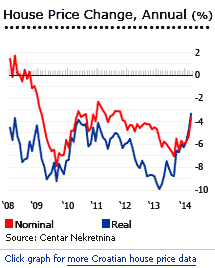 House prices are falling in Croatia - and they’ve been falling for six years. It has been a long gloomy road:
House prices are falling in Croatia - and they’ve been falling for six years. It has been a long gloomy road:
- In 2009, the national property price index dropped 4.8% y-o-y (-6.5% in real terms)
- In 2010, the index dropped 4.8% (-6.5% in real terms)
- In 2011, the national property price index dropped 1.3% (-3.3% in real terms)
- In 2012, the national property price index dropped 3.1%
- In 2013, the national property price index fell by about 4.9%.
In Croatia’s capital, Zagreb, the average asking price of flats fell by 3.7% during the year to end-Q1 2014, to €1,565 per square metres (sq. m.). When adjusted for inflation, the asking price declined by 3.3%.
Smaller house price falls were experienced on the Adriatic Coast, where the average asking price of flats declined by just 0.5% during the year to Q1 2014, to €1,600 per sq. m.
The latest quarter saw the lowest annual decline since October 2011, according to CentarNekretnina. So maybe Croatia is coming to the end of its long period of house-price declines? Maybe Croatia’s accession to European Union on July 1, 2013 will be the beginning of a new era?
Most districts suffered from house price declines, except for Novi Zagreb-Zapad (2.3%) and Trešnjevka jug (1.1%). Novi Zagreb-Istok had the sharpest price drop, declining by 9.7% to €1,260, during the year to March 2014, followed by Trnje (-7.1%), Podsused-Vrapče (-6.9%), Donja Dubrava (-6.4%) and Pešćenica-Žitnjak (-6%).
The upper town of Medveščak has the most expensive apartments, with an average asking price of €2,139 per sq. m. in March 2014. Apartments are also expensive in the Center, with an average price of € 2,003 per sq. m.
With its accession to the European Union, the Croatian economy is expected to be more open. However, the benefits of the accession to the housing market will not be significantly felt immediately, especially since the country is still suffering from stagnation.
The property market has been adversely affected by the Euro zone sovereign debt crisis. In 2013, the economy contracted by 1%, after GDP declines of 1.9% in 2012, 0.24% in 2011, 2.3% in 2010, and 6.9% in 2009, according to the International Monetary Fund (IMF). The economy is expected to contract by 0.62% this year before returning to meagre growth in 2015.
Croatia’s spectacular coast
There are about 70,000 foreigners who own property in Croatia, mostly on the Adriatic Coast. Due to complexities regarding taxation and foreign ownership rules, most bought through a company.
However, amendments were made to the Croatian Law on Ownership implemented in February 2009, and now treats EU nationals as Croatian citizens for the purposes of acquiring real estate in Croatia. The legislation aims to ease the buying process and attract more buyers to the country.
Non-EU foreign nationals, on the other hand, may buy a property in Croatia based on reciprocity agreement between Croatia and the foreign buyer’s home country.
Real estate is more actively traded on the Adriatic and other popular tourist destinations. The Northern peninsula of Istria is home to a property boom fuelled by German buying.
Around 55% of approved permits for foreign acquisitions were granted to Germans. Austrians come in second place with 16% of permits granted, followed by Britons (6%), Hungarians (4%) and Dutch (3%).
Of Croatia’s 20 counties (or regions), the five most popular with foreign buyers are on the Adriatic Coast: Istria (33% of foreign-owned properties), Primorje-Gorski Kotar (26%), Split-Dalmatia (12%), Zadar (8%), and Dubrokniv-Neretva (6%). Only 3% of foreign buyers chose Zagreb City.
Housing supply near Civil War levels!
In non-tourist Croatia, supply continues to fall rapidly. Amazingly, current levels of completions and permits issued are close to levels during the War of Independence (1991-1995), when dwelling completions fell to less than 10,000 annually from the previous range of 20,000-30,000 annually between 1981 and 1990. From an average of 24,366 annual housing completions 2006-2008, completed flats fell to 11,792 units in 2012.
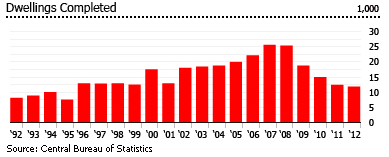
This year will be significantly worse.
9,742 permits were issued in 2012, down from 23,344 permits issued annually from 2003-2008. Again this year will be significantly worse. As of August 2013, the number of dwelling permits issued was only at 4,678, down by 32% from 6,884 permits recorded by August 2012.
The shift from socialism to a market economy saw much privatization in favour of authoritarian President Fradjo Tudjman’s cronies. Dwelling construction increased to an average of 12,787 units p.a. from 1996 to 1999, still far from enough.
Tudjman’s death in December 1999 and the subsequent election of a new government led to substantial reforms in the economy and a sudden increase in house prices in 1999. As a result, construction surged to 17,487 completions in the year 2000. Around 18,000 dwellings were completed annually from 2002 to 2005. During 2006-2008, completions rose even further, exceeding 20,000 units annually, while permits issued ranges from 24,000 to 25,000. Improved economic conditions combined with the launch of cheap housing programs and changes in ownership laws, plus new zoning restrictions and building regulations, then led to further increases in construction activity.
Slower mortgage market growth despite low interest rates
Croatia’s mortgage market expanded from 4.7% of GDP in 2000 to 19.1% of GDP in 2012, with the decline of interest rates during the years to 2007. The surge of housing loans occurred from 2002 to 2007, as the amount of outstanding housing loans rose annually by an average of 29%.
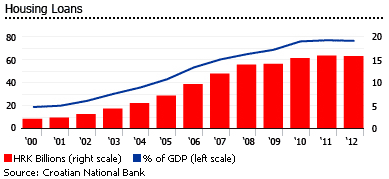
However with Croatia’s economy n the doldrums the past two years, outstanding housing loans grew by only 3.3% in 2011, and contracted by 0.7% in 2012.
Nevertheless, Croatia’s mortgage market has developed significantly during the past decade. The old large state-owned banks have been privatized, and commercial banks have been restructured. Austrian, Italian and German banks have entered the market. There was a significant increase observed in the building societies’ share of loans, from 1% in 2003 to 5% in 2010.
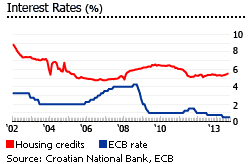
As of August 2013, interest rates on housing credits loans were 5.5% , up from 5.4% last July. Most mortgages in Croatia are variable rate, indexed to the euro (previously to the deutschemark) or Swiss Francs.
Interest rates are expected to be fall because of Croatia´s entry to the European Union in July 1, 2013, due to anticipated direct competition from foreign banks.
Rental market small, moderate yields
Most of Croatians are owner-occupiers. 92% of Croatian households own a house or apartment, according to Zagreb nekretnine Ltd (ZANE).
Croatia’s long-term rental market is very small, concentrating on short-term holiday rentals for foreigners and tourists. Most long-term rental properties are Zagreb, Dubronik, and Split.
In Zagreb, the demand for rental properties partly comes from students studying at the University of Zagreb, as in Split, where the greatest demand is in the city center and around the university campus.
Depending on the equipment and location, monthly rents in Zagreb for one-bedroom apartments range from €200 to €250, while two-bedroom apartments can be rented at around €300. A 50 sq. m. apartment in Zagreb can be rented at around HRK 2,741 (€360) per month, while monthly rent for a larger 175 sq. m. apartment is around HRK 13,706 (€1,800).
The scarcity of good resort waterfront real estate on Adriatic coast is expected to continuously fuel strong rental demands. Rents for three-bedroom seaside flats located in the Adriatic Coast range from HRK 11,787 (€1,548) to HRK 27,526 (€3,615) per month. Two-bedroom houses in the same area can be rented from HRK 11,467 (€1,506) to HRK 16,835 (€2,211) per month, according to the www.longtermlettings.com.
Gross rental yields in Croatia’s capital, Zagreb, are moderate, at around 4.56% to 5.60% for apartments, while houses have better yields ranging from 7.92% to 8.87%, according to a Global Property Guide research conducted in September 2011. There is no particular connection between size of apartment and yields.
The boom years
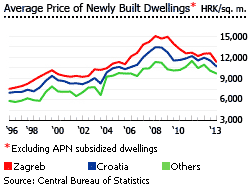
The high point of the boom was perhaps 2007, an exceptional year in the Croatian housing markets. The average price of newly built dwellings in Croatia surged 26% to HRK 11,252 (€1,477) per sq. m. from HRK 8,939 (€1,173) in 2006. This was in sharp contrast to 0.7% (3.9% in real terms) drop in house prices in 2005, and the negligible 0.3% increase in 2006 (2.8% drop in real terms).
While housing demand and supply has been increasing since 2001, the erratic movement of house prices can probably be attributed to changes in speculative demand. Wealthy Croatians traditionally park their wealth in housing in times of uncertainty. For instance, when the economy started to weaken in late 1998, demand for new housing increased substantially. The average price of new houses rose by almost 20% in 1999 - the year of President Fradjo Tudjman’s death - while the economy contracted 0.8%.
GDP has fallen 12% since 2008
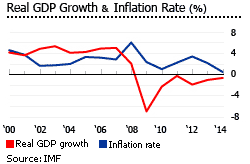
Croatia’s economy has been depressed for five years, losing more than 12% of GDP since 2008. In 2013, the economy contracted by 1%, after real GDP declines of 1.9% in 2012, 0.24% in 2011, 2.3% in 2010, and 6.9% in 2009, based on figures from the International Monetary Fund (IMF).
Unlike other new European Union members which experienced an economic boost after their accession, Croatia, which joined the EU on July 1, 2013, rather entered at a time when EU is struggling. The IMF expects the Croatian economy to remain in recession this year before returning to meagre growth in 2015. The Croatian government has revised its forecast down this year from 1.3%, first down to 0.2%, and now down to zero economic growth.
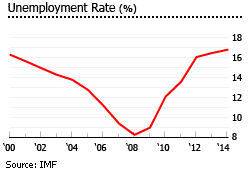
The Croatian government is expected to cut investments and subsidies and raise excise taxes on petrol and telecom operators to reduce its budget deficit by about HRK1.3 billion (€171 million) to meet the requirements set by the European Commission.
Moreover, in another attempt to slow Croatia’s budget deficit and public debt, the government moved to privatize its last state-owned bank last year.
The country’s budget deficit is expected at 4.5% of GDP this year, down from an estimated deficit of 5.5% of GDP in 2013, but up from 3.8% of GDP in 2012. The country’s public debt is expected to rise to 62% of GDP this year, up from 55% of GDP in 2013.
Fitch Ratings downgraded Croatia’s credit rating to junk last September 2013. Before Fitch, Standard & Poor’s already downgraded Croatia’s rating to junk status in December 2012, followed by Moody’s Investors Service in February 2013.
In March 2014, Croatia saw its consumer prices drop by another 0.1% from the same period last year, after falling by 0.2% in the previous month, according to Eurostat. From 2009 to 2013, the country’s average annual inflation rate was 2.3%, according to the IMF.
Croatia’s most serious problem is its very high unemployment. Croatia had the fourth highest unemployment rate among EU countries, following Greece, Spain and Cyprus. In March 2014, Croatia’s unemployment rate was 17.3%, up from 16.6% in the same period last year, according to Eurostat.